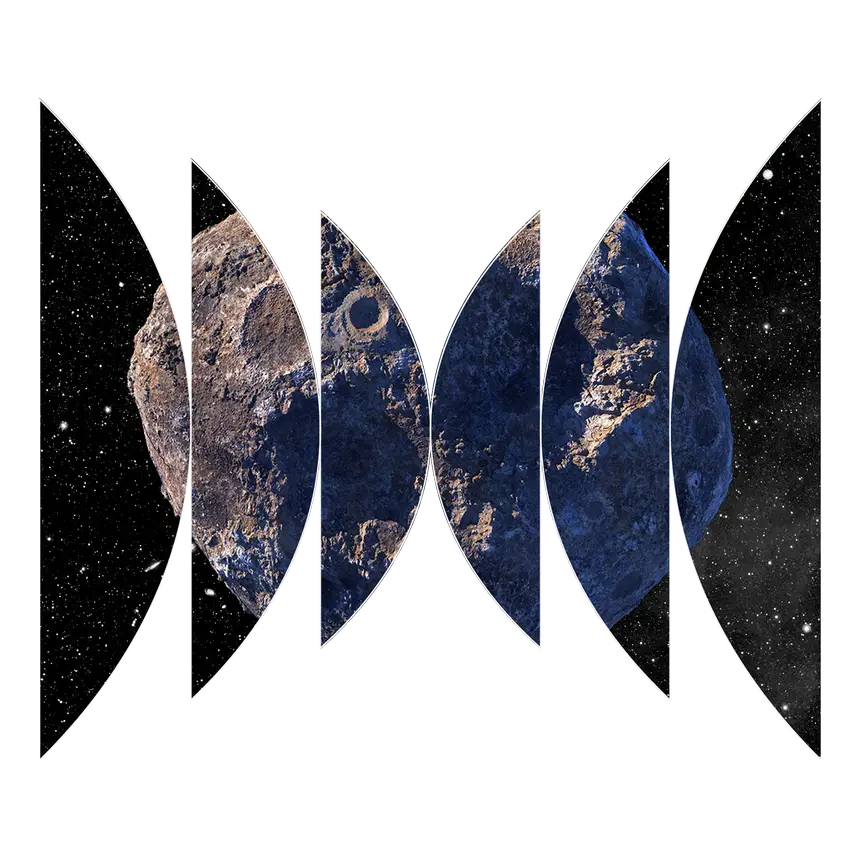
Name a Quasi-Moon
A global naming contest from Radiolab and the International Astronomical Union.

Voting has now ended. And the winner is...
CARDEA
Here is the official announcement from the International Astronomical Union.
About The Finalists
Bakunawa
[ bah-koo-nah-wah ]
Submitted by Arjay L (the Philippines), Enzo M (the Philippines)
Bakunawa, a mythical dragon from Philippine folklore, is said to rise from the ocean to swallow the moon, explaining lunar eclipses in ancient times. This fearsome serpent, associated with powerful natural events, embodies the mysterious and formidable nature of the quasi-moon, which appears and disappears from sight. Naming the quasi-moon Bakunawa would honor pre-colonial Philippine mythology and inspire pride and connection among Filipinos, bringing an ancient cultural story to the forefront of global astronomy.
Cardea
[ kar-dee-ah ]
Submitted by Clay C (USA)
A name imbued with elegance and depth, Cardea is the Roman goddess of doorways and transitions, symbolizing the guardianship of thresholds. This quasi-moon, forever straddling the space between Earth and the cosmos, reflects Cardea's dominion over liminal states, embodying a celestial gatekeeper of the in-between.
Ehaema
[ eh-hey-ma ]
Submitted by Liisi A (Estonia)
Rooted in Estonian folklore, Ehaema, the "Mother Twilight," embodies the serene, mysterious moments of dusk. She symbolizes the delicate balance between light and darkness, guiding people to complete their work before nightfall. This quasi-moon, suspended between Earth and the vastness of space, mirrors Ehaema's gentle reminder of transitions and the quiet beauty of twilight.
Enkidu
[ en-kee-doo ]
Submitted by Aaron C (USA), Moira P (USA), Aaron F (USA), Brent J (USA)
Named after the wild and noble companion from the ancient Sumerian Epic of Gilgamesh, Enkidu represents both wild freedom and loyal friendship. Like Enkidu's presence on the fringes of civilization, this quasi-moon orbits close yet distinct from Earth, embodying the bond between two entities sharing space, destined to part ways in time.
Ótr
[ oh-tr ]
Submitted by Grzegorz B (Poland)
A shape-shifting dwarf from Norse mythology, Ótr spent his days in the form of an otter, navigating the boundaries between human and wild realms. This quasi-moon, with its quiet presence and potential for both playfulness and mystery, mirrors the qualities of Ótr—observant, elusive, and always near yet unseen. The choice highlights the moon's interaction with Earth, subtly woven into our cosmic neighborhood.
Tarriaksuk
[ tah-ree-ahk-sook ]
Submitted by Samuel L (USA)
The Tarriaksuk of Inuit legend are shadow beings that mirror human forms yet dwell in another dimension. Like these beings, this quasi-moon mimics the true moon but follows a unique, transient path, appearing briefly before vanishing into the dark. The name underscores themes of duality and fleeting visibility, aligning with the moon's parallel, shadow-like existence.
Tecciztecatl
[ teh-siz-teh-kahtl ]
Submitted by Muhammad Hussain R (Pakistan), Claudia C (USA), Gabriel G (Mexico)
An Aztec lunar god who once aspired to be the sun, Tecciztecatl's hesitant leap into the fire ultimately destined him for the moon. His story is echoed in the quasi-moon's orbit—neither sun nor true moon but a celestial presence cast in the role of an eternal companion. The name pays tribute to indigenous stories that often go unrecognized in modern space nomenclature.
Meet the Panel
What is a Quasi-Moon?
Naming Contest & Voting FAQ
How did we get our quasi-moon name finalists?
Inspired by Radiolab’s Zoozve episode, Radiolab and the International Astronomical Union (IAU) put out a call soliciting names for Earth's quasi-moon. We received over 2,700 name submissions from 96 countries! Our panel of judges narrowed it down to a list of finalists with a voting rubric, panel discussion, and vetting by the IAU and cultural leaders.
What was the rating rubric used to choose the top 10?
- 50% Creativity & Uniqueness: Does the name stand out as original or clever?
- 40% Relevance to the Quasi-Moon's Properties: How well does the name relate to the astronomical or scientific aspects of the quasi-moon?
- 10% Effort & Thought: Does the submission reflect thoughtfulness and effort in its explanation?
What are the official naming rules for the Name a Quasi-Moon Contest?
Read the official contest rules for full naming guidelines.
What’s a quasi-moon?
A quasi-moon is a space rock that orbits the sun nearby a planet. Weirdly, if you watch it from the planet, it looks like it’s going around you the way a moon would. But it’s too small and too far away to be a moon. And it’s barely being pulled around by the planet’s gravity. So it’s just hanging out, doing this funny awkward cosmic dance with the planet. Not a moon, but also not NOT a moon.
What does quasi-moon (164207) 2004 GU9 look like?
(164207) 2004 GU9 is a quasi-moon that will be with us (the Earth) until about the year 2600. It’s a gray rocky asteroid, about 500 feet across, likely potato shaped, with little jagged edges all over it.
Where can I read all the submissions?
To get full details, read this document about the final name submissions.